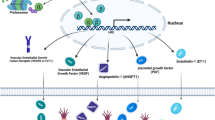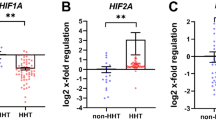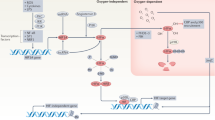Abstract
Anti-ischemic therapy remains a challenge due to the complexity of hypoxia response pathways. Hypoxia-inducible factor (HIF)-1 is a heterodimer transcription factor consisting of 2 subunits, HIF-1α and HIF-1β. Hypoxia-dependent activation of HIF-1α regulates cellular O2 homeostasis. Raynaud syndrome (RS), as a comorbidity of the autoimmune disease systemic sclerosis (SS), is characterized by vasospasms that limit blood flow to the limbs, resulting in hypoxia. A single-center randomized study was conducted to compare prostaglandin E1 (PgE1) therapy with a treatment combining PgE1 and an endothelin-1 blocker, bosentan. A total of 30 patients suffering from SS with RS were enrolled. We examined the regulation of HIF-1α, its target heme oxygenase-1 (HMOX-1), and the serum levels of the HIF-1α protein in a subset of patients as well as in ten healthy individuals. The expression of HIF-1α and HMOX-1 in monocytes was measured using absolute plasmid-based quantitative real-time PCR, whereas serum HIF-1α levels were measured with ELISA. Samples were taken at the time of randomization and after 24 weeks. We found that HIF-1α and HMOX-1 mRNA expression in monocytes and serum HIF-1α protein levels were significantly higher in the SS/RS patients compared to the healthy control group. Single-drug therapy significantly increased HIF-1α and HMOX-1 mRNA expression in monocytes and serum HIF-1α protein levels in the SS/RS patients compared to those at the time of randomization, whereas combining PgE1 with an endothelin-1 blocker prevented the further increases in HIF-1α and HMOX-1 expression. We propose HIF-1α and HMOX-1 as novel markers for anti-ischemic therapy in RS.
Similar content being viewed by others
Log in or create a free account to read this content
Gain free access to this article, as well as selected content from this journal and more on nature.com
or
References
Semenza GL. Hypoxia-inducible factor 1: master regulator of O2 homeostasis. Curr Opin Genet Dev. 1998;8:588–94.
Semenza GL, Agani F, Booth G, Forsythe J, Iyer N, Jiang BH, et al. Structural and functional analysis of hypoxia-inducible factor 1. Kidney Int. 1997;51:553–5.
Wang GL, Jiang BH, Rue EA, Semenza GL. Hypoxia-inducible factor 1 is a basic-helix-loop-helix-PAS heterodimer regulated by cellular O2 tension. Proc Natl Acad Sci USA. 1995;92:5510–4.
Lee PJ, Jiang BH, Chin BY, Iyer NV, Alam J, Semenza GL, et al. Hypoxia-inducible factor-1 mediates transcriptional activation of the heme oxygenase-1 gene in response to hypoxia. J Biol Chem. 1997;272:5375–81.
Hu J, Discher DJ, Bishopric NH, Webster KA. Hypoxia regulates expression of the endothelin-1 gene through a proximal hypoxia-inducible factor-1 binding site on the antisense strand. Biochem Biophys Res Commun. 1998;245:894–9.
Miao RZ, Liu LQ, Chen L, Li Z, Li LP, Guo RL, et al. Activity of heme oxygenase-1 affects expression levels of hypoxia inducible factor-1 gene in vitro. Chin Med J. 2012;125:1310–5.
Semenza GL. HIF-1: mediator of physiological and pathophysiological responses to hypoxia. J Appl Physiol. 1985;2000:1474–80.
Bardos JI, Ashcroft M. Negative and positive regulation of HIF-1: a complex network. Biochim Biophys Acta. 2005;1755:107–20.
Deng W, Feng X, Li X, Wang D, Sun L. Hypoxia-inducible factor 1 in autoimmune diseases. Cell Immunol. 2016;303:7–15.
van Hal TW, van Bon L, Radstake TR. A system out of breath: how hypoxia possibly contributes to the pathogenesis of systemic sclerosis. Int J Rheumatol. 2011;2011:824972.
Grader-Beck T, Wigley FM. Raynaud’s phenomenon in mixed connective tissue disease. Rheum Dis Clin North Am. 2005;31:465–81.
Belch JJ. Raynaud’s phenomenon: its relevance to scleroderma. Ann Rheum Dis. 1991;50(Suppl 4):839–45.
Kaufman MW, All AC. Raynaud’s disease: patient education as a primary nursing intervention. J Vasc Nurs. 1996;14:34–9.
Herrick A, Muir L. Raynaud’s phenomenon (secondary). BMJ Clin Evid. 2014;2014:pii: 1125.
Sunderkotter C, Riemekasten G. Pathophysiology and clinical consequences of Raynaud’s phenomenon related to systemic sclerosis. Rheumatology. 2006;45(Suppl 3):iii33–5.
LeRoy EC, Medsger TA Jr. Raynaud’s phenomenon: a proposal for classification. Clin Exp Rheumatol. 1992;10:485–8.
Distler JH, Jungel A, Pileckyte M, Zwerina J, Michel BA, Gay RE, et al. Hypoxia-induced increase in the production of extracellular matrix proteins in systemic sclerosis. Arthritis Rheum. 2007;56:4203–15.
Wei J, Bhattacharyya S, Tourtellotte WG, Varga J. Fibrosis in systemic sclerosis: emerging concepts and implications for targeted therapy. Autoimmun Rev. 2011;10:267–75.
Korn JH, Mayes M, Matucci Cerinic M, Rainisio M, Pope J, Hachulla E, et al. Digital ulcers in systemic sclerosis: prevention by treatment with bosentan, an oral endothelin receptor antagonist. Arthritis Rheum. 2004;50:3985–93.
Mohrland JS, Porter JM, Smith EA, Belch J, Simms MH. A multiclinic, placebo-controlled, double-blind study of prostaglandin E1 in Raynaud’s syndrome. Ann Rheum Dis. 1985;44:754–60.
Creutzig A, Lehmacher W, Elze M. Meta-analysis of randomised controlled prostaglandin E1 studies in peripheral arterial occlusive disease stages III and IV. Vasa. 2004;33:137–44.
Matucci-Cerinic M, Denton CP, Furst DE, Mayes MD, Hsu VM, Carpentier P, et al. Bosentan treatment of digital ulcers related to systemic sclerosis: results from the RAPIDS-2 randomised, double-blind, placebo-controlled trial. Ann Rheum Dis. 2011;70:32–8.
Jaipersad AS, Lip GY, Silverman S, Shantsila E. The role of monocytes in angiogenesis and atherosclerosis. J Am Coll Cardiol. 2014;63:1–11.
Elbarghati L, Murdoch C, Lewis CE. Effects of hypoxia on transcription factor expression in human monocytes and macrophages. Immunobiology. 2008;213:899–908.
Sambo P, Jannino L, Candela M, Salvi A, Donini M, Dusi S, et al. Monocytes of patients with systemic sclerosis (scleroderma) spontaneously release in vitro increased amounts of superoxide anion. J Invest Dermatol. 1999;112:78–84.
Christmann RB, Lafyatis R. The cytokine language of monocytes and macrophages in systemic sclerosis. Arthritis Res Ther. 2010;12:146.
Ziello JE, Jovin IS, Huang Y. Hypoxia-Inducible Factor (HIF)-1 regulatory pathway and its potential for therapeutic intervention in malignancy and ischemia. Yale J Biol Med. 2007;80:51–60.
Frede S, Stockmann C, Freitag P, Fandrey J. Bacterial lipopolysaccharide induces HIF-1 activation in human monocytes via p44/42 MAPK and NF-kappaB. Biochem J. 2006;396:517–27.
Li G, Lu WH, Ai R, Yang JH, Chen F, Tang ZZ. The relationship between serum hypoxia-inducible factor 1alpha and coronary artery calcification in asymptomatic type 2 diabetic patients. Cardiovasc Diabetol. 2014;13:52.
Hull TD, Agarwal A, George JF. The mononuclear phagocyte system in homeostasis and disease: a role for heme oxygenase-1. Antioxid Redox Signal. 2014;20:1770–88.
Wenzel P, Rossmann H, Muller C, Kossmann S, Oelze M, Schulz A, et al. Heme oxygenase-1 suppresses a pro-inflammatory phenotype in monocytes and determines endothelial function and arterial hypertension in mice and humans. Eur Heart J. 2015;36:3437–46.
Hettema ME, Zhang D, Bootsma H, Kallenberg CG. Bosentan therapy for patients with severe Raynaud’s phenomenon in systemic sclerosis. Ann Rheum Dis. 2007;66:1398–9.
Marasini B, Massarotti M, Bottasso B, Coppola R, Del Papa N, Maglione W, et al. Comparison between iloprost and alprostadil in the treatment of Raynaud’s phenomenon. Scand J Rheumatol. 2004;33:253–6.
Wipff J, Dieude P, Avouac J, Tiev K, Hachulla E, Granel B, et al. Association of hypoxia-inducible factor 1A (HIF1A) gene polymorphisms with systemic sclerosis in a French European Caucasian population. Scand J Rheumatol. 2009;38:291–4.
Higgins DF, Kimura K, Bernhardt WM, Shrimanker N, Akai Y, Hohenstein B, et al. Hypoxia promotes fibrogenesis in vivo via HIF-1 stimulation of epithelial-to-mesenchymal transition. J Clin Invest. 2007;117:3810–20.
Wenger RH, Kvietikova I, Rolfs A, Gassmann M, Marti HH. Hypoxia-inducible factor-1 alpha is regulated at the post-mRNA level. Kidney Int. 1997;51:560–3.
Grygiel-Gorniak B, Puszczewicz M. Oxidative damage and antioxidative therapy in systemic sclerosis. Mediat Inflamm. 2014;2014:389582.
Pialoux V, Mounier R, Brown AD, Steinback CD, Rawling JM, Poulin MJ. Relationship between oxidative stress and HIF-1 alpha mRNA during sustained hypoxia in humans. Free Radic Biol Med. 2009;46:321–6.
Zhang Y, Li L, Hua Y, Nunn JM, Dong F, Yanagisawa M, et al. Cardiac-specific knockout of ET(A) receptor mitigates low ambient temperature-induced cardiac hypertrophy and contractile dysfunction. J Mol Cell Biol. 2012;4:97–107.
Niecknig H, Tug S, Reyes BD, Kirsch M, Fandrey J, Berchner-Pfannschmidt U. Role of reactive oxygen species in the regulation of HIF-1 by prolyl hydroxylase 2 under mild hypoxia. Free Radic Res. 2012;46:705–17.
Qutub AA, Popel AS. Reactive oxygen species regulate hypoxia-inducible factor 1alpha differentially in cancer and ischemia. Mol Cell Biol. 2008;28:5106–19.
Bellando-Randone S, Lepri G, Bruni C, Blagojevic J, Radicati A, Cometi L, et al. Combination therapy with Bosentan and Sildenafil improves Raynaud’s phenomenon and fosters the recovery of microvascular involvement in systemic sclerosis. Clin Rheumatol. 2016;35:127–32.
Hafner F, Thomas G, Froehlich H, Steidl K, Brodmann M. Effect of a sequential therapy of bosentan and iloprost versus a monotherapy with bosentan in the treatment of scleroderma related digital ulcers. Int Angiol. 2011;30:493–5.
Cawello W, Leonhardt A, Schweer H, Seyberth HW, Bonn R, Lomeli AL. Dose proportional pharmacokinetics of alprostadil (prostaglandin E1) in healthy volunteers following intravenous infusion. Br J Clin Pharmacol. 1995;40:273–6.
Xue L, Chen H, Lu K, Huang J, Duan H, Zhao Y. Clinical significance of changes in serum neuroglobin and HIF-1alpha concentrations during the early-phase of acute ischemic stroke. J Neurol Sci. 2017;375:52–7.
Ishii T, Itoh K, Takahashi S, Sato H, Yanagawa T, Katoh Y, et al. Transcription factor Nrf2 coordinately regulates a group of oxidative stress-inducible genes in macrophages. J Biol Chem. 2000;275:16023–9.
Panchenko MV, Farber HW, Korn JH. Induction of heme oxygenase-1 by hypoxia and free radicals in human dermal fibroblasts. Am J Physiol Cell Physiol. 2000;278:C92–101.
Pachori AS, Melo LG, Zhang L, Solomon SD, Dzau VJ. Chronic recurrent myocardial ischemic injury is significantly attenuated by pre-emptive adeno-associated virus heme oxygenase-1 gene delivery. J Am Coll Cardiol. 2006;47:635–43.
Loboda A, Jozkowicz A, Dulak J. HIF-1 and HIF-2 transcription factors--similar but not identical. Mol Cells. 2010;29:435–42.
Acknowledgements
This work was supported in part by the German Heart Foundation (project number K/26/13).
Author contributions
LAH and IA designed the study; LAH, MK, MM and DS performed the research; LAH, MK, MH, SR, DD, CB, CH, and IH analyzed the data; and LAH and MH wrote the manuscript.
Author information
Authors and Affiliations
Corresponding author
Ethics declarations
Competing interests
The authors declare no competing interests.
Additional information
Publisher’s note: Springer Nature remains neutral with regard to jurisdictional claims in published maps and institutional affiliations.
Rights and permissions
About this article
Cite this article
Heger, L.A., Kerber, M., Hortmann, M. et al. Expression of the oxygen-sensitive transcription factor subunit HIF-1α in patients suffering from secondary Raynaud syndrome. Acta Pharmacol Sin 40, 500–506 (2019). https://doi.org/10.1038/s41401-018-0055-1
Received:
Accepted:
Published:
Issue date:
DOI: https://doi.org/10.1038/s41401-018-0055-1
keywords
This article is cited by
-
Hypoxia-Inducible Factor-1α (HIF-1α) as a Biomarker for Changes in Microcirculation in Individuals with Systemic Sclerosis
Dermatology and Therapy (2023)
-
Hypoxia signaling in human health and diseases: implications and prospects for therapeutics
Signal Transduction and Targeted Therapy (2022)



